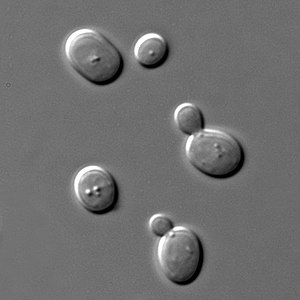Yeast (Saccharomyces Cerevisiae): Difference between revisions
No edit summary |
|||
| Line 16: | Line 16: | ||
* [[Model Organism]] | * [[Model Organism]] | ||
* {{SeeWikipedia}} | * {{SeeWikipedia|Saccharomyces cerevisiae}} | ||
== References == | == References == | ||
<references /> | <references /> | ||
[[Category:Model Organism]] | [[Category:Model Organism]] | ||
Revision as of 02:50, 8 December 2023
Saccharomyces cerevisiae (brewer's yeast or baker's yeast) is a species of yeast (single-celled fungus microorganisms). The species has been instrumental in winemaking, baking, and brewing since ancient times. It is believed to have been originally isolated from the skin of grapes. It is one of the most intensively studied eukaryotic model organisms in molecular and cell biology, much like Escherichia coli as the model bacterium. S. cerevisiae cells are round to ovoid, 5–10 μm in diameter. It reproduces by budding.[1]
Model organism

When researchers look for an organism to use in their studies, they look for several traits. Among these are size, generation time, accessibility, manipulation, genetics, conservation of mechanisms, and potential economic benefit. The yeast species S. pombe and S. cerevisiae are both well studied; these two species diverged approximately 600 to 300 million years ago, and are significant tools in the study of DNA damage and repair mechanisms.[2]
S. cerevisiae has developed as a model organism because it scores favorably on a number of these criteria.
- As a single-cell organism, S. cerevisiae is small with a short generation time (doubling time 1.25–2 hours[3] at 30 °C or 86 °F) and can be easily cultured. These are all positive characteristics in that they allow for the swift production and maintenance of multiple specimen lines at low cost.
- S. cerevisiae divides with meiosis, allowing it to be a candidate for sexual genetics research.
- S. cerevisiae can be transformed allowing for either the addition of new genes or deletion through homologous recombination. Furthermore, the ability to grow S. cerevisiae as a haploid simplifies the creation of gene knockout strains.
- As a eukaryote, S. cerevisiae shares the complex internal cell structure of plants and animals without the high percentage of non-coding DNA that can confound research in higher eukaryotes.
- S. cerevisiae research is a strong economic driver, at least initially, as a result of its established use in industry.
See Also
- Model Organism
- Wikipedia - Saccharomyces cerevisiae

